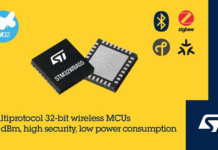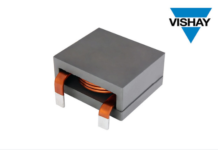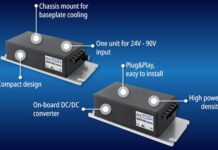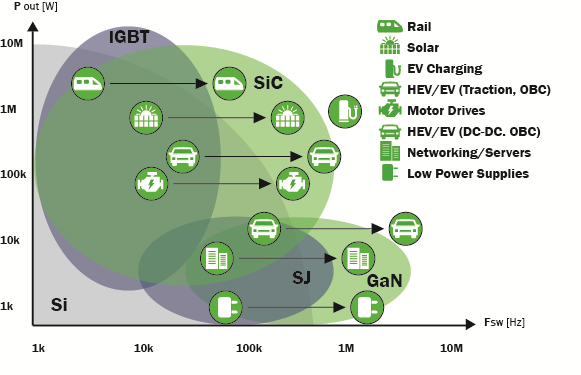
For decades, silicon has dominated the transistor world. But that has been gradually changing. Compound semiconductors made of two or three materials have been developed and offer unique benefits and superior characteristics. For example, compound semiconductors gave us the light emitting diode (LED). One type is made up of a mix of Gallium Arsenide (GaAs) and Gallium Arsenide and Phosphorus (GaAsP). Others use indium and phosphorous.
The problem is that compound semiconductors are harder to make and more expensive. Yet, they offer significant benefits over silicon. New more demanding applications such as automotive electrical systems and electric vehicles (EVs) are finding that compound semiconductors better meet their stringent specifications.
Two such compound semiconductor devices that have emerged as solutions are Gallium Nitride (GaN) and Silicon Carbide (SiC) power transistors. These devices compete with the long−lived silicon power LDMOS MOSFETs and the super−junction MOSFETs. The GaN and SiC devices are similar in some ways but also have significant differences. This article compares the two and offers up some facts to help you make a decision for your next design.
Figure 1. Power Capability vs. Switching Frequency for Popular High Voltage, High Current Transistors and Other Devices is Shown, as well as the Primary Applications
Wide Bandgap Semiconductors
Compound semiconductors are referred to as wide bandgap (WBG) devices. Without resorting to a review of crystal lattice structures, energy levels, and other mind−numbing semiconductor physics, let’s just say that the definition of WBG is a model that attempts to describe how current (electrons) flows in a compound semiconductor.
WBG compound semiconductors have high electron mobility and higher bandgap energy, translating into characteristics that are superior to silicon. Transistors made from WBG compound semiconductors have higher breakdown voltages and greater tolerance of high temperatures. These devices are superior to silicon for high−voltage and high−power applications.
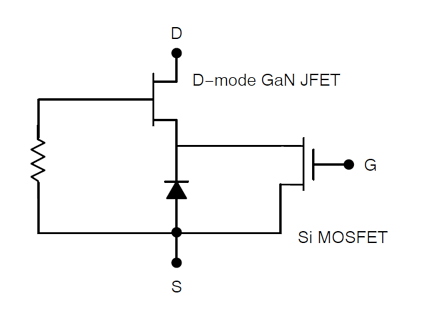
WBG transistors also switch faster and can operate at higher frequencies than silicon. Lower “on” resistance means they dissipate less power, thereby promoting efficiency. This unique combination of characteristics makes these devices attractive for some of the most demanding circuits used in automotive applications, especially hybrid and electric vehicles.
GaN and SiC transistors are becoming readily available to address the challenges of the automotive electrical equipment. The key take−aways for GaN and SiC devices are these advantages:
- High−voltage capability with devices for 650, 900 and 1200 V;
- Faster switching speed;
- Higher operating temperature; and
- Lower conduction resistance with minimum power dissipation and greater efficiency.
GaN Transistors
GaN transistors found an early niche in the radio frequency (RF) power field. The nature of the materials led to the development of a field effect transistor (FET) of the depletion mode type. Called a pseudomorphic high electron mobility transistor (pHEMT), depletion (or D mode) FETs are naturally “on” devices; with no gate control input, a natural conduction channel exists. Gate input signals control the channel conduction and turn the device on and off.
Since normally “off” enhancement (or E mode) devices are preferred in switching applications, this led to the development of E−mode GaN devices. The first was a cascode of two FET devices (Figure 2). Now, standard e−mode GaN devices are available. They can switch at frequencies up to 10 MHz and up to tens of kW.
GaN devices are widely used in wireless equipment as power amplifiers at frequencies up to 100 GHz. Some of the primary use cases are cellular base station power amplifiers, military radar, satellite transmitters, and general RF amplification. However, because of their high voltage (up to 1,000 V), high temperature, and fast switching, they have also been incorporated into a variety of switch−mode power supply applications such as DC−DC converters, inverters, and battery chargers.
SiC Transistors
SiC transistors are natural E−mode MOSFETs. These devices can switch at frequencies as high as 1 MHz at voltage and current levels much higher than silicon MOSFETs. Maximum drain−source voltage is up to about 1,800 V with a current capability to 100 amperes. In addition, the on−resistance of SiC devices is much lower than that of silicon MOSFETs, making them more efficient in all switching power applications (SMPS designs). One key disadvantage is they require a higher gate drive voltage than other MOSFETs, although this is changing as designs improve.
The SiC devices need 18 to 20 volts of gate voltage drive to turn on the device with a low on−resistance. Standard Si MOSFETs only require a gate of less than 10 volts for full conduction. In addition, the SiC devices need a −3 to −5 − V gate drive for switching to the off state. However, special gate drive ICs have been developed to meet this need. The SiC MOSFETs are generally more costly than other alternatives, but their high−voltage, high−current capability make them well−suited to automotive power circuits.
WBG Transistor Competition
Both GaN and SiC devices compete with other well−established semiconductors, specifically Silicon LDMOS MOSFETs, super junction MOSFETs, and IGBTs. In many applications, these older devices are gradually being replaced by the GaN and SiC transistors.
For example, IGBTs are being replaced by SiC devices in many applications. The SiC devices can switch at higher frequencies (100 kHz + vs. 20 kHz), thereby permitting the reduction in size and cost of any inductors or transformers while simultaneously increasing efficiency. Also, SiC can handle more current than GaN.
Summarizing the GaN vs. SiC comparison, here are the highlights:
- GaN switches faster than Si;
- SiC operates at higher voltages than GaN;
- SiC requires high gate drive voltage; and
- Super junction MOSFETs are gradually being replaced by both GaN and SiC. SiC appears to be the favorite for on−board chargers (OBCs). This trend will not doubt continue as engineers discover the newer devices and gain experience with them.
Automotive Applications
Many power circuits and devices can be improved by designing with GaN and SiC. One of the biggest beneficiaries is automotive electrical systems. Modern hybrid and all−electrical vehicles contain equipment that can use these devices. Some of the popular applications are OBCs, DC−DC converters, motor drivers, and LIDAR. Figure 3 points out the main subsystems in an EV that require high power switching transistors.
Figure 3. A WBG On−board Charger (OBC) for HEVs and EVs. The AC Input is Rectified, Power Factor Corrected (PFC), then DC−DC Converted (One Output for Charging the HV Battery and the Other for Charging the LV Battery)
DC−DC Converters. This is a power circuit that converts the high battery voltage down to a lower voltage to operate other electrical equipment. Battery voltages now range up to 600 or 900 volts. A DC−DC converter drops this down to 48 or 12 volts or both for the operation of other electronic components (Figure 3). In hybrid electric vehicles and EVs (HEVEVs), a DC−DC can also be used on the High Voltage BUS between the battery pack and the Inverter.
On−Board Chargers (OBCs). Plug−in HEVEVs and EVs contain an internal battery charger that connects to an AC power source. This allows at−home charging without an external AC−to−DC charger (Figure 4).
Traction Motor Driver. The traction motor is the high output AC motor that drives the vehicle’s wheels. The driver is an inverter that converts the battery voltage into three−phase AC that operates the motor.
LIDAR. LiDAR refers to a technology that incorporates both light and radar methods to detect and identify surrounding objects. It scans an area of 360 degrees with a pulsating infrared laser and detects the reflected light. This information is translated into a detailed 3D picture of the scenes out to about 300 meters with a resolution of several centimeters. Its high resolution makes it an ideal sensor for vehicles, especially self−driving, to improve the identification of nearby objects. LiDAR units operate from a DC voltage in the 12− to 24−volt range that is derived from a DC−DC converter.
Figure 4. A Typical DC−DC Converter is Used for Translating High Battery Voltages to 12 and / or 48 Volts. The IGBTs Used in the HV Bridge are Gradually being Replaced by SiC MOSFETs
Because of their high voltage, high current, and rapid switching, both GaN and SiC transistors offer the automotive electrical designer forgiving and easier designs plus superior performance.





